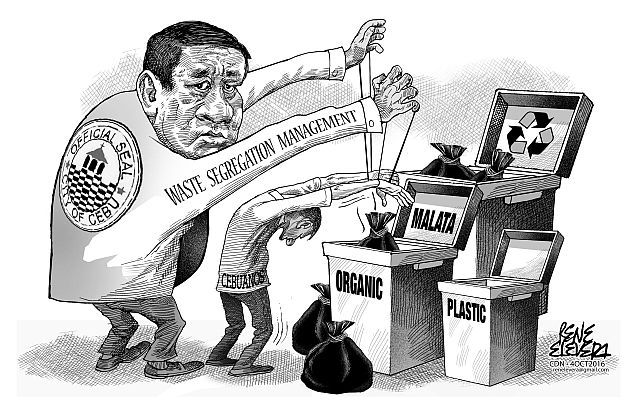
The initial week-long assessment of Cebu City Hall that half of city residents were unable to practice waste segregation should not be used as an excuse to discontinue nor diminish it as a priority program to resolve the city’s garbage problem.
In fact, it should be taken as a challenge by the Osmeña administration to intensify its implementation, unlike in the previous administration which appeared to have given up and relied on, even prioritized the transportation of the city’s mounting garbage to, a private landfill facility in Consolacion town.
Last week, the city government started spraying enzymes to the garbage mountains of the Inayawan dumpsite to offset the stench emanating from them. We hope the chemical treatments won’t cause any fires soon owing to the rising volume of methane there.
How this will impact on the surrounding area remains to be seen, but it will still be useful if the city government conducts weekly air quality monitoring tests to determine if the stench had been reduced significantly or not.
Among those who welcomed the re-opening of the Inayawan dumpsite were the scavengers since it meant a resumption of their livelihood. The closure meant they were barred from entering the site since the garbage was supposedly sorted through and segregated by trained garbage collectors of Cebu City Hall.
Again, City Hall can perhaps take a page or even borrow the whole playbook of its neighbor Mandaue City which appeared to have done a better job in dealing with their garbage problem despite not having the billions of pesos in revenue that Cebu City has at its disposal.
For starters, Mandaue has achieved some modest success in implementing its plastic ban with commercial businesses and households following suit, thanks to Mayor Luigi Quisumbing’s low key yet visible campaigning of the policy.
There is a plastic ban ordinance in Cebu City, but it is limited only to Wednesdays and the large number of commercial businesses in the city have rendered its implementation only as a half measure, just like half of city residents who have willingly followed the city’s waste segregation program.
But should the waste segregation program be neglected, or worse, dropped altogether? Ultimately the responsibility of ensuring the success of the program which will benefit everyone living in the city lies with the city residents themselves.
That is the obvious answer, but it’s how to get more if not all city residents cooperate with the waste segregation program that is the challenge faced by former councilors Nida Cabrera and Robert Cabarrubias, who were tapped by the mayor to help implement the waste segregation program and waste collection program respectively.
Aside from mapping out a future landfill site which Cebu City should have done years before the Inayawan dumpsite was declared unfit to continue operating, City Hall should pursue the waste segregation program in new, creative ways to make sure that they get public support for this critical initiative.
Perhaps they can start by placing more color-coded garbage receptacles in public areas to make garbage collectors’ jobs easier. City residents need not wait for more city streets to be filled with mountains of uncollected garbage for them to do something about it.